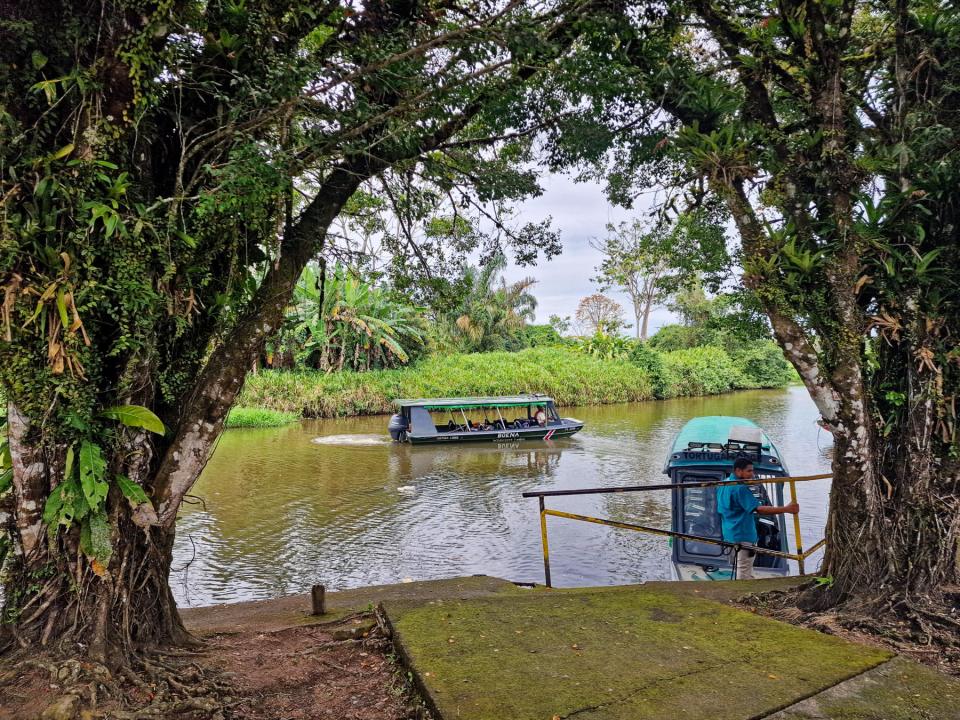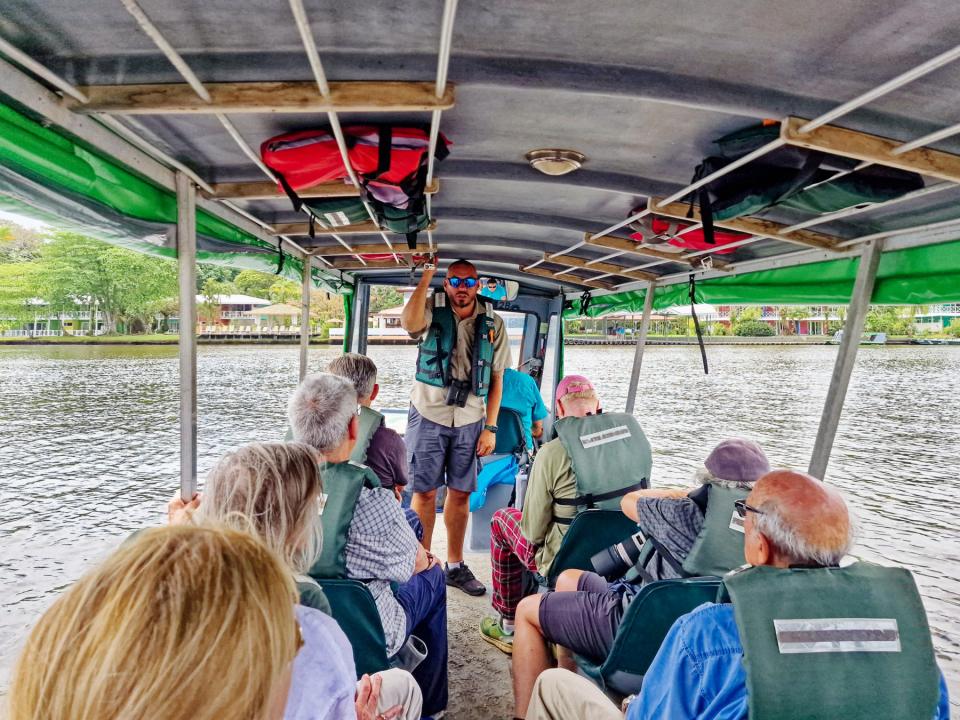Thursday 2 March 2023 – Two activities were in the frame for the day, both (surprise!) involving wildlife watching and, as it happens, both led by Miguel “Monkey” with his usual blend of passion, knowledge and cheeriness. The first was a morning boat ride around the local waters to catch wildlife at the start of the day so, guess what? An early start. Again. Fourth time on the trot. No wonder I’m such a poor wildlife photographer normally. I can’t be arsed to get up at the right time to catch them at it. However, when we’re travelling, early mornings seem to be (a) not uncommon and (b) normally quite a good idea.
0430 alarm, then.
The Lodge was, as ever, well organised. Breakfast is not served until later, but coffee, tea and biccies were available before we set off at 0600. In fact, the relentless stream of never-before-seen wildlife started before then, as a Green Basilisk Lizard could be seen on a branch, waiting for the sun to warm him up.

We set off in an open boat similar to this one (and grateful that it wasn’t raining),

past some engagingly ramshackle properties on the waterside

and soon Miguel took the boat towards the bank and started indulging in his favourite game: “What can you see? It’s right in front of your nose”. As usual, I couldn’t see anything apart from foliage, but after patient guidance from Miguel and Jane, I eventually spotted the sloth.

You can make out a dark strip down its back, which means it’s a male three-toed sloth. Of course.
We saw a selection of birds at the water’s edge.
We saw another sloth, also a three-toed sloth, as you can see the three finger claws identifying it.

You can also clearly see the green tinge on part of its coat. This is moss, which won’t gather on a rolling stone but will on an immobile sloth.
Miguel had some more fun with us being unable to see what was in front of our noses. Eventually, we all spotted it.


A Caiman – a small one, actually. They can grow to four and a half metres, but this one was much smaller. Exactly how much smaller, I don’t know since everything except snout and eyes was underwater.
Miguel then took us into the system of creeks around the area, which have some lovely scenes


and, of course, more wildlife that was difficult to spot.

These are Boat-billed Night Herons and they couldn’t have been more than a couple of metres away. However, because I was looking for something further away, my eyes initially slid over what was actually directly in front of me and quite close.
We had a little cabaret with Green Ibises. There was a female in a tree

and, in an adjacent tree, three males were fighting over her.
Typical male behaviour, eh? Fighting for a shag, or, in this case, an Ibis.
Some obvious things could be seen, such as the Greater Spotted Kayakers (well, I spotted them, anyway)

who were also trawling the creeks for wildlife.
Miguel called the Charlie a “feminist”. Each female’s territory encompasses those of one to four males who (unusually) do all the hard work – building nests, looking after the chicks, that stuff. The females are larger than the males and get to do the macho things like fighting off predators.
We saw another Caiman, a Spectacled Caiman, so-called because of the bony ridge which you can just see running between the eyes,

and some Spider Monkeys, including one very well-endowed male.


and then it was time to get back to the Lodge for breakfast.
Our second excursion of the day was to walk up the only hill in the area. I made a bit of a tactical error here by using my camera’s normal lens (instead of the lovely long lens which has enabled me to bring some of the photos above to you) because I thought the emphasis of the walk would be on scenery rather than wildlife, Our guide was Miguel again, so that was the wrong call, but the walk wasn’t an entire dead loss, photographically speaking.
The start was a boat ride away, and, as we waited to board, one of the Lodge’s resident iguanas came over to see what was going on.

A shortish boat ride took us to our start point, where we were counted off the boat by officials from the national park.

The trail around the hill is a concrete path with information boards at various points. Miguel, being Miguel, almost immediately spotted something that it took the rest of us quite some time to see, It’s in this scene.

Can you see any animal there? I never really got to see what was there, which was a Potoo.

That’s the best I can do – it’s roughly in the centre of the picture and it’s a weird-looking beast, one of a group of birds related to the nightjars and frogmouths.
Jane had a go with her phone and got frankly better results than me – but it’s not at all clear, which makes it all the more remarkable that Miguel could see it.

Here’s what one looks like close to (courtesy of Encyclopedia Britannica).

Potoo (image credit – Britannica.com)
To be honest, I’m not sure that having the longer lens would have helped, but I was a bit frustrated about my choice of gear.
Anyhoo…
We carried on walking, and came across a Pale-billed Woodpecker doing his wood pecking thing.
and we saw another Eyelash Palm Pitviper.

These vipers are potentially deadly, but not big. Miguel broke his own rule by getting off the path to take a close up for someone. You can just see the viper on the left of the picture.

We also came across some more Spider Monkeys

before we started our climb of the steps that take one up The Hill.

We were told that there were 402 steps. Wrongly, as it turns out. I counted them and I reckon there are 431. Anyway, the view from the top is pretty good.

The village you can see is San Francisco de Tortuguero, and you can also see that the land is generally very flat. If you look towards the hill from above the Lodge, you can see that the hill is the only significant high spot in the area. It was originally created by volcanic activity.

A short boat ride back to the Lodge completed our activities for the day, a day made all the more enjoyable, absorbing and educational by the passion and knowledge of “Monkey”. Here’s to you Miguel!

Having returned to the Lodge, we could head for lunch and the rest of the day at leisure – or, in my case, writing up things for these pages.
Whilst I was doing that, Jane took some video of Montezuma’s Oropendolas flying in and out of their extraordinary nests, which were dangling from a palm tree in the Lodge grounds.
Thus ended our short stay at Tortuga Lodge – good food, excellent service, great guiding, and overall a very well-executed operation. The morrow sees us moving on to our next port of call on the Caribbean coast in the south east of the country. The vibe here is reportedly very different from the rest of Costa Rica, so come along with us and find out, eh?















































